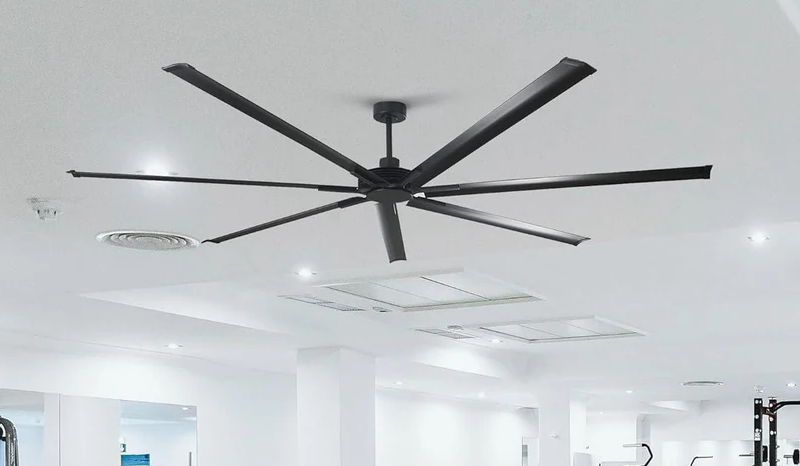If you walk into any home improvement store in the U.S. and browse ceiling fans, you’ll see a lot of beautiful fixtures… and almost no clear answer to the question people actually Google:
“How many watts is a standard ceiling fan?”
As a lighting and fan retailer, we talk about ceiling fan wattage with customers every single day. The short version is:
-
A typical residential ceiling fan uses about 15–75 watts while running, depending on size and speed.
-
Most “standard” 52-inch fans on medium or high speed land somewhere around 40–60 watts.
-
Older or less efficient AC-motor fans can hit 80–100+ watts, while modern DC-motor and ENERGY STAR fans can stay under 30 watts on high.
Below, we’ll break down real-world wattage ranges, show how much electricity that actually uses in different U.S. states, and explain what really affects a fan’s power draw so you can pick the right model without guessing.
How Many Watts Is a “Standard” Ceiling Fan?
When people say “standard ceiling fan,” they usually mean a 52-inch, 5-blade fan with a conventional AC motor and maybe a light kit. That size is very common in American living rooms and bedrooms.
Industry testing and recent energy guides show that:
-
Most residential ceiling fans fall between 15 and 100 watts while running, depending on size and speed.
-
Modern fans without lights average 15–75 watts on low to high speeds.
For a typical 52-inch “standard” fan, you’ll commonly see:
-
Low speed: around 20–30 W
-
Medium speed: around 30–45 W
-
High speed: around 50–75 W
Older fans and bargain models can run higher, especially at top speed. By contrast, some high-efficiency models run significantly lower, especially with DC motors or ENERGY STAR certification.
So if you’re just looking for a ballpark number, you can think of a standard ceiling fan as using about the same power as a bright LED light bulb or two—far less than almost any air conditioner.
How Many Watts Do DC and AC Ceiling Fans Use?
If you’ve been shopping recently, you’ve probably seen “AC motor” vs “DC motor” in fan descriptions. The motor type makes a big difference in wattage.
Traditional AC-Motor Fans
Most ceiling fans installed in American homes over the last few decades use AC induction motors. Typical ranges:
-
Traditional AC fans: roughly 50–100 watts at higher speeds, depending on size and design.
That’s still pretty efficient compared with air conditioning, but a lot higher than newer DC options.
Modern DC (Brushless) Ceiling Fans
DC motor technology has become mainstream in the last few years. These motors use electronics to convert 120V AC power to efficient DC and precisely control speed.
Recent efficiency guides and manufacturer data show:
-
DC ceiling fans typically use about 15–30 watts, compared with 50–100 watts for older AC fans of similar size.
-
Many DC fans hit 70% energy savings at equivalent airflow levels.
In practical terms, a 52-inch DC fan on high might draw 25–35 W instead of 60–75 W. If you run that fan for long hours in a hot climate like Texas or Florida, the savings add up over time.
ENERGY STAR Ceiling Fans
ENERGY STAR–certified fans are tested for efficiency in cubic feet per minute per watt (CFM/W) and must meet strict performance thresholds.
Recent buyer’s guides note that many ENERGY STAR ceiling fans:
-
Use less than 30 watts on high speed while still moving plenty of air.
These are almost always DC-motor fans or very efficient AC designs.
Reverse Mode in Winter
Most ceiling fans, AC or DC, have a reverse switch for winter operation. Reversing the fan doesn’t magically change the wattage; what matters is the speed setting:
-
Reverse at low speed usually draws 10–30 W, just enough to gently push warm air off the ceiling.
-
Reverse at high speed can draw the same power as forward high, but you rarely need that in winter.
What Affects Ceiling Fan Wattage?
If you pick three different 52-inch fans off the shelf, they won’t necessarily use the same wattage. Several design choices impact power draw.
Fan Size (Blade Span)
Bigger fans move more air and usually use more power. Data from recent fan wattage studies shows:
-
Small fans (30–40")
-
~15–30 W on low, up to ~50 W on high
-
-
Medium fans (42–48")
-
~20–40 W on low, up to ~60 W on high
-
-
Large fans (52"+)
-
~30–50 W on low, up to ~75–100 W on high
-
That is why we always ask about room size first when helping customers choose a model: you want enough airflow without overspending on wattage.
Speed Setting
Speed is the second big factor. Higher RPM needs more power:
-
On many fans, high speed can use 2–3 times the watts of low speed.
-
Some modern DC fans on breeze or Eco modes can draw as little as 3–10 W at their lowest settings.
If you tend to run your fan all night while sleeping, using medium instead of high can significantly lower energy use.
Motor Technology and Efficiency
As we covered above, DC motors generally use less power than older AC motors for the same airflow. Fan efficiency is often rated in CFM per watt (CFM/W); higher CFM/W = more air per watt of electricity.
Two 52-inch fans on high might both move around 5,000–6,000 CFM, but:
-
An older AC fan could draw 70–90 W
-
A high-efficiency DC or ENERGY STAR fan might draw 25–35 W
From a retailer’s point of view, this is where the “cheap” fans and the “nice” fans diverge over the long term.
Blade Design and Pitch
Blade count, shape, and angle (pitch) all change how much power is required:
-
Steeper pitch and wider blades move more air but increase drag, so wattage goes up.
-
Efficient designs optimize blade shape so you still get strong airflow without massive power draw.
This is why it’s not enough to look only at watts; airflow in CFM matters just as much for comfort.
Lights and Extras
Many ceiling fans include integrated LED lights, remotes, and smart controls:
-
A modern LED light kit might add 10–20 W when on—far less than old incandescent kits that could add 180 W from three 60 W bulbs.
-
Remote receivers and smart modules draw small amounts of standby power, usually under 1–2 W.
When you see “80 watts” on a spec sheet, check whether that includes the light or just the fan motor.
Average Wattage by Fan Size
Let’s put the ranges into a simple size-based chart using recent data from U.S. energy experts and utilities.
Typical Running Wattage by Fan Size and Speed
(Motor only, no lights)
| Fan size (diameter) | Speed setting | Typical wattage (traditional AC fan) | Typical wattage (modern DC / ENERGY STAR) |
|---|---|---|---|
| 30–40 inch | Low | 15–25 W | 5–15 W |
| Medium | 25–35 W | 10–20 W | |
| High | 35–50 W | 15–30 W | |
| 42–48 inch | Low | 20–30 W | 6–18 W |
| Medium | 30–45 W | 12–25 W | |
| High | 45–60 W | 18–35 W | |
| 52–56 inch | Low | 30–40 W | 8–20 W |
| Medium | 40–55 W | 15–30 W | |
| High | 55–75+ W | 25–40 W |
These are averages, not hard rules, but they give you a realistic idea of where most products land in 2024–2025.
If you’re comparing two fans side by side and one 52-inch model uses 70 W on high while another uses 28 W to move similar air, the second one is clearly the more efficient design.
How Much Electricity Does a Ceiling Fan Use?
Watts tell you how fast a fan uses power. To see how much you’ll actually pay, you care about energy over time, measured in kilowatt-hours (kWh).
The Basic Formula
Energy use in kWh:
kWh = (Fan wattage × Hours used) ÷ 1,000
Example:
A 60-watt ceiling fan running for 5 hours:
-
60 W × 5 hours = 300 watt-hours
-
300 ÷ 1,000 = 0.3 kWh
If your local electricity rate is 18 cents per kWh, that costs:
-
0.3 × $0.18 ≈ 5 cents
Real-World Examples: National Average vs Texas vs California
According to recent mapping of residential electricity prices, the national average in 2024 was around 13.0 cents per kWh, and by mid-2025 many sources report averages in the 17–19 cents per kWh range as prices have climbed.
Rates vary a lot by state, so let’s use rough examples:
-
National 2025 average: about $0.18/kWh
-
Texas average: around $0.15/kWh (many fixed-rate plans land here)
-
California average: can exceed $0.30/kWh in many investor-owned utility territories.
Now let’s compare two fans:
-
Standard 52-inch AC fan: 60 W on medium
-
High-efficiency DC fan: 25 W on medium
Assume you run the fan 8 hours per day for a hot summer month (30 days).
Energy use per month
-
AC fan: 60 W × 8 h × 30 ÷ 1,000 = 14.4 kWh
-
DC fan: 25 W × 8 h × 30 ÷ 1,000 = 6.0 kWh
Approximate monthly cost
| Location | AC fan (60 W) | DC fan (25 W) |
|---|---|---|
| National avg (18¢/kWh) | 14.4 × 0.18 ≈ $2.59 | 6.0 × 0.18 ≈ $1.08 |
| Texas (~15¢/kWh) | ≈ $2.16 | ≈ $0.90 |
| California (~30¢/kWh) | ≈ $4.32 | ≈ $1.80 |
Even with rising electricity prices, ceiling fans are cheap to run, especially compared with central air conditioners that typically draw 2,000–5,000 watts.
The big financial win is actually using fans so you can raise your thermostat. Studies on DC fans note that combining fans with AC and bumping the thermostat up by 4–6°F can reduce cooling costs by 30–40% overall.
Does Running a Ceiling Fan Longer Increase Its Power Draw?
This is a subtle but important question. A lot of people worry that “running the fan all day” will somehow make the wattage creep up.
Wattage vs Energy
-
Wattage (W) is the instant power draw at a given speed.
-
Energy (kWh) is watts multiplied by time.
For a given fan at a fixed speed, the wattage is basically constant. If a fan uses 40 W on medium, it will stay around 40 W whether you run it for 10 minutes or 10 hours.
What increases with longer run time is total energy used, not the instantaneous wattage:
-
40 W for 1 hour = 0.04 kWh
-
40 W for 10 hours = 0.4 kWh
Your monthly bill cares about the sum of all those hours, not the fact that the fan runs “too long” at a higher wattage.
Does Age or Dust Make Fans Use More Power?
In theory, a badly worn motor or extremely dirty bearings could increase friction and slightly raise current draw, but in real-world residential use:
-
Most fans either keep running at roughly the same wattage or fail outright.
-
Regular dusting of blades and occasional lubrication (if your model requires it) is more about safety and noise than large energy changes.
As long as the fan is balanced, not overheating, and not making grinding noises, you can assume its wattage is basically what’s on the label or in the manual.
FAQ:
Q1:How can I find the exact wattage of my ceiling fan?
A:Look at the nameplate label on the fan motor housing or check the specification sheet in the manual or online product page. Newer fans often list wattage at different speeds or provide airflow efficiency in CFM/W.
Q2:Is a 100-watt ceiling fan “bad”?
A:Not automatically, but it is on the high side for normal residential fans today. Many modern models deliver the same or better airflow using 30–60 W, and high-efficiency DC or ENERGY STAR fans often use under 30 W on high. If you’re buying new and see a 100 W rating, compare its airflow and efficiency to alternatives.
Q3:Does a ceiling fan use more electricity with the light on?
A:Yes, but how much depends on the light source. A modern LED kit might add 10–20 W. An older incandescent kit with three 60 W bulbs can add 180 W. If you still have incandescent bulbs, swapping to LED is one of the easiest savings wins you can grab.
Q4:Is it okay to run a ceiling fan 24/7?
A:From an energy standpoint, running even a 60-W fan all day costs less than many small appliances, but you’re still paying for every hour. From a safety standpoint, a properly installed fan that is not wobbling or overheating can run long hours. In practice, most people turn them off when they leave a room—both for safety and to avoid wasting even cheap energy, because fans cool people, not rooms.
Q5:Does running a ceiling fan make the air conditioner work harder?
A:No. A fan simply moves air; it doesn’t add significant heat to the room. In fact, using ceiling fans allows you to set the thermostat a bit higher while feeling just as comfortable, which reduces AC run time and overall energy use.
Q6:Is a higher wattage fan always better at cooling?
A:Not necessarily. What matters more is airflow (CFM) and efficiency (CFM per watt). A high-efficiency 35-W DC fan might move as much air as a 70-W older fan. Always look at the airflow numbers, not just wattage.
Q7:What’s the difference between 120V and watts on a ceiling fan label?
-
120V is the voltage of U.S. household power.
-
Watts measure how much power the fan actually uses at that voltage.
Most residential ceiling fans in the U.S. are 120-volt devices. Within that standard, designers can create fans that use very different watts depending on motor, size, and efficiency.
Final Thoughts
So, how many watts is a standard ceiling fan? In most American homes, your “everyday” 52-inch fan is pulling somewhere around 40–60 watts on a comfortable medium speed, give or take. Modern DC and ENERGY STAR models can cut that in half, while older or cheap fans might pull more.










